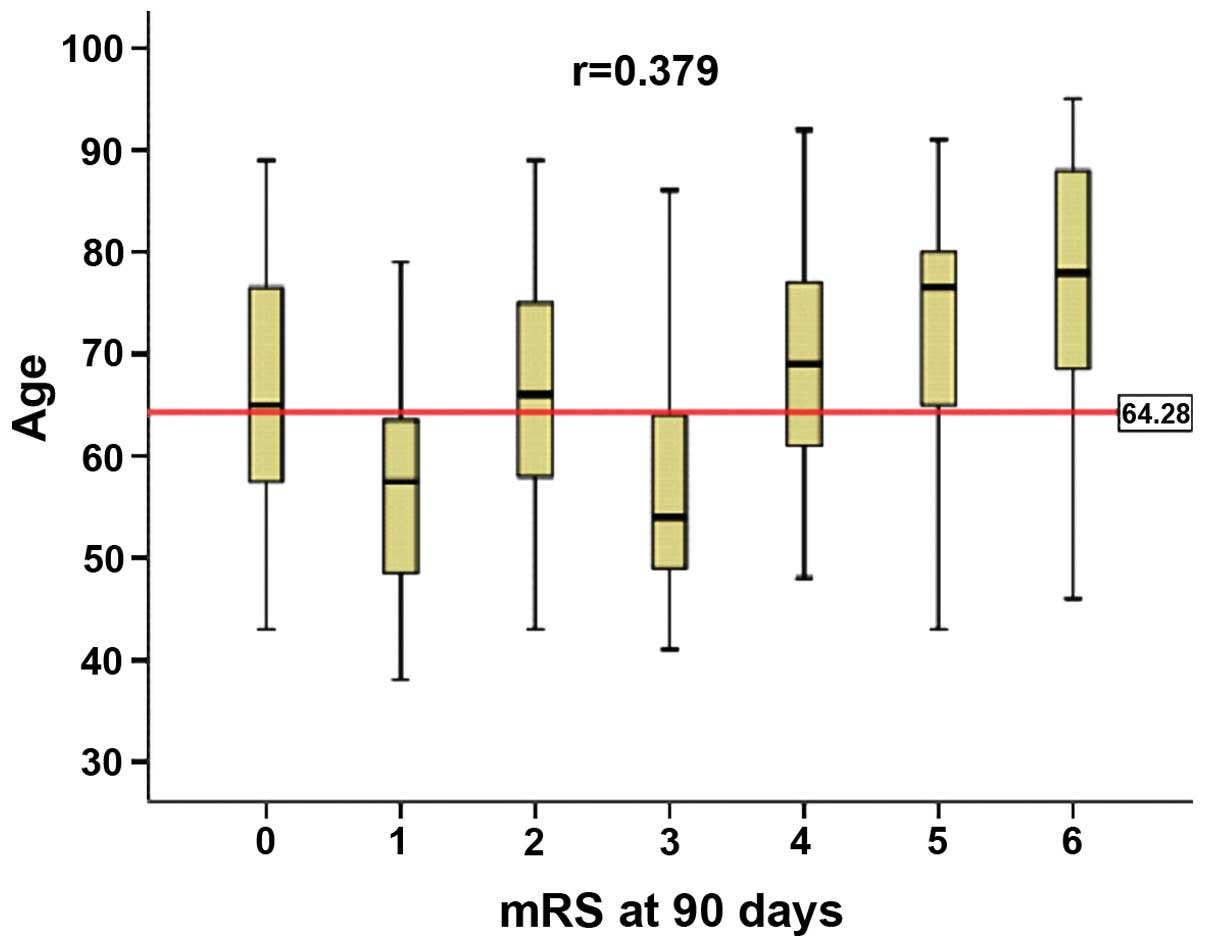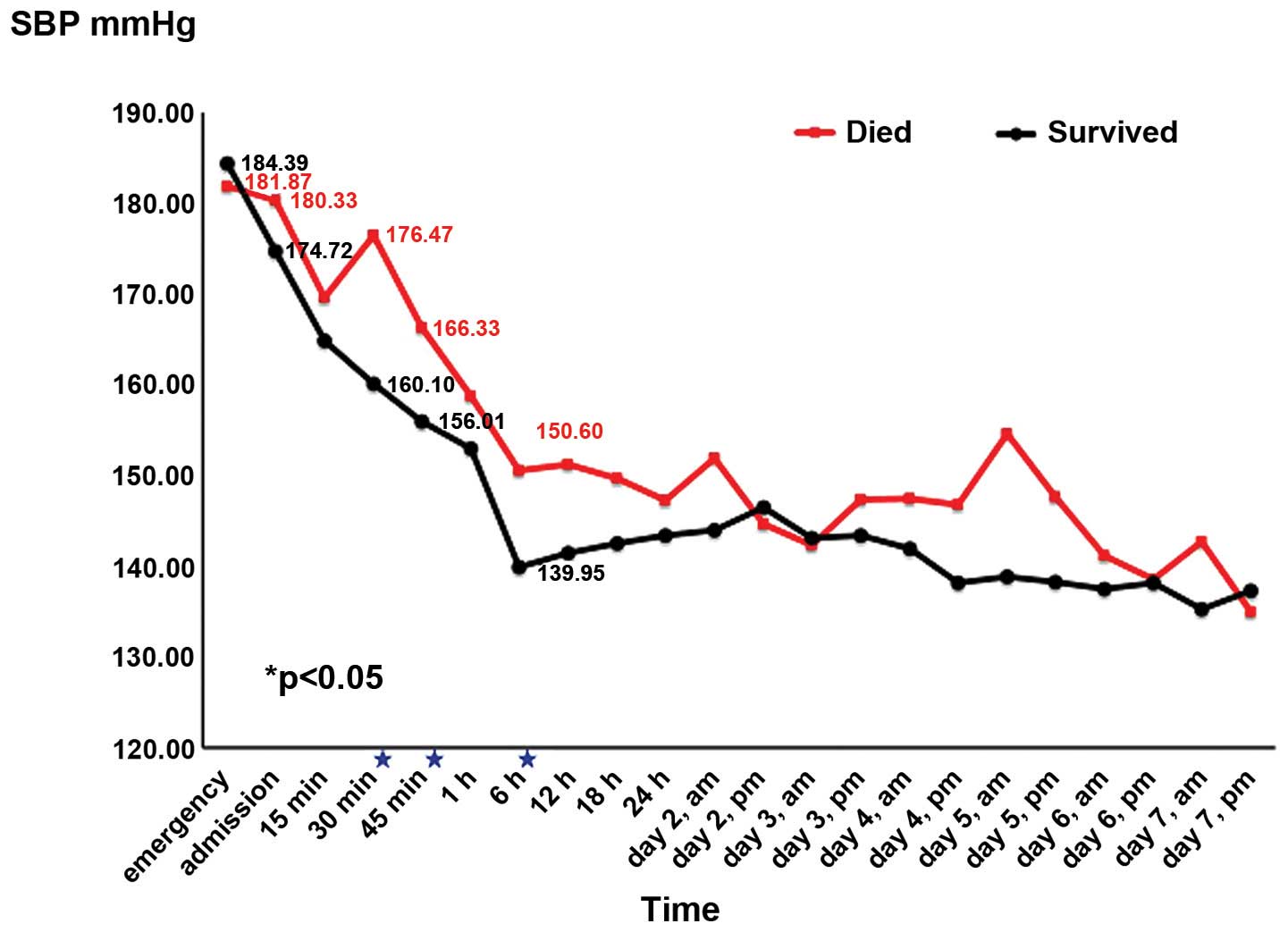|
1
|
Zhang Y, Yi B, Ma J, Zhang L, Zhang H,
Yang Y and Dai Y: Quercetin promotes neuronal and behavioral
recovery by suppressing inflammatory response and apoptosis in a
rat model of intracerebral hemorrhage. Neurochem Res. 40:195–203.
2015. View Article : Google Scholar : PubMed/NCBI
|
|
2
|
Sia SF, Tan KS and Waran V: Primary
intracerebral haemorrhage in Malaysia: in-hospital mortality and
outcome in patients from a hospital based registry. Med J Malaysia.
62:308–312. 2007.PubMed/NCBI
|
|
3
|
Nilsson OG, Lindgren A, Brandt L and
Säveland H: Prediction of death in patients with primary
intracerebral hemorrhage: A prospective study of a defined
population. J Neurosurg. 97:531–536. 2002. View Article : Google Scholar : PubMed/NCBI
|
|
4
|
Chen HS, Hsieh CF, Chau TT, Yang CD and
Chen YW: Risk factors of in-hospital mortality of intracerebral
hemorrhage and comparison of ICH scores in a Taiwanese population.
Eur Neurol. 66:59–63. 2011. View Article : Google Scholar : PubMed/NCBI
|
|
5
|
Stein M, Luecke M, Preuss M, Boeker DK,
Joedicke A and Oertel MF: Spontaneous intracerebral hemorrhage with
ventricular extension and the grading of obstructive hydrocephalus:
the prediction of outcome of a special life-threatening entity.
Neurosurgery. 67:1243–1251; discussion 1252. 2010. View Article : Google Scholar : PubMed/NCBI
|
|
6
|
Davis SM, Broderick J, Hennerici M, Brun
NC, Diringer MN, Mayer SA, Begtrup K and Steiner T: Recombinant
Activated Factor VII Intracerebral Hemorrhage Trial Investigators:
Hematoma growth is a determinant of mortality and poor outcome
after intracerebral hemorrhage. Neurology. 66:1175–1181. 2006.
View Article : Google Scholar : PubMed/NCBI
|
|
7
|
Zia E, Engstrom G, Svensson PJ, et al:
Three-year survival and stroke recurrence rates in patients with
primary intracerebral hemorrhage. Stroke. 40:3567–3573. 2009.
View Article : Google Scholar : PubMed/NCBI
|
|
8
|
Broderick JP, Adams HP Jr, Barsan W,
Feinberg W, Feldmann E, Grotta J, Kase C, Krieger D, Mayberg M,
Tilley B, et al: Guidelines for the management of spontaneous
intracerebral hemorrhage: a statement for healthcare professionals
from a special writing group of the Stroke Council, American Heart
Association. Stroke. 30:905–915. 1999. View Article : Google Scholar : PubMed/NCBI
|
|
9
|
Bath P, Chalmers J, Powers W, Beilin L,
Davis S, Lenfant C, Mancia G, Neal B, Whitworth J and Zanchetti A:
International Society of Hypertension Writing Group: International
Society of Hypertension (ISH): statement on the management of blood
pressure in acute stroke. J Hypertens. 21:665–672. 2003. View Article : Google Scholar : PubMed/NCBI
|
|
10
|
Hanger HC, Wilkinson T, Keeling S and
Sainbury R: New Zealand guideline for management of stroke. N Z Med
J. 117:U8632004.PubMed/NCBI
|
|
11
|
Baños-González M, Cantú-Brito C, Chiquete
E, Arauz A, Ruiz-Sandoval JL, Villarreal-Careaga J,
Barinagarrementeria F and Lozano JJ: Systolic blood pressure and
functional outcome in patients with acute stroke: a Mexican
registry of acute cerebrovascular disease (RENAMEVASC). Arch
Cardiol Mex. 81:169–175. 2011.(In Spanish). PubMed/NCBI
|
|
12
|
Anderson CS, Heeley E, Huang Y, Wang J,
Stapf C, Delcourt C, Lindley R, Robinson T, Lavados P, Neal B, et
al: INTERACT2 Investigators: Rapid blood-pressure lowering in
patients with acute intracerebral hemorrhage. N Engl J Med.
368:2355–2365. 2013. View Article : Google Scholar : PubMed/NCBI
|
|
13
|
Tetri S, Huhtakangas J, Juvela S,
Saloheimo P, Pyhtinen J and Hillbom M: Better than expected
survival after primary intracerebral hemorrhage in patients with
untreated hypertension despite high admission blood pressures. Eur
J Neurol. 17:708–714. 2010. View Article : Google Scholar : PubMed/NCBI
|
|
14
|
Tsivgoulis G, Katsanos AH, Butcher KS,
Boviatsis E, Triantafyllou N, Rizos I and Alexandrov AV: Intensive
blood pressure reduction in acute intracerebral hemorrhage: a
meta-analysis. Neurology. 83:1523–1529. 2014. View Article : Google Scholar : PubMed/NCBI
|
|
15
|
Gould B, McCourt R, Gioia LC, Kate M, Hill
MD, Asdaghi N, Dowlatshahi D, Jeerakathil T, Coutts SB, Demchuk AM,
et al: ICH ADAPT Investigators: Acute blood pressure reduction in
patients with intracerebral hemorrhage does not result in
borderzone region hypoperfusion. Stroke. 45:2894–2899. 2014.
View Article : Google Scholar : PubMed/NCBI
|
|
16
|
Grise EM and Adeoye O: Blood pressure
control for acute ischemic and hemorrhagic stroke. Curr Opin Crit
Care. 18:132–138. 2012. View Article : Google Scholar : PubMed/NCBI
|
|
17
|
Arima H, Wang JG, Huang Y, Heeley E,
Skulina C, Parsons MW, Peng B, Li Q, Su S, Tao QL, et al: INTERACT
Investigators: Significance of perihematomal edema in acute
intracerebral hemorrhage: the INTERACT trial. Neurology.
73:1963–1968. 2009. View Article : Google Scholar : PubMed/NCBI
|
|
18
|
Steiner T and Bösel J: Options to restrict
hematoma expansion after spontaneous intracerebral hemorrhage.
Stroke. 41:402–409. 2010. View Article : Google Scholar : PubMed/NCBI
|
|
19
|
Anderson CS, Huang Y, Arima H, Heeley E,
Skulina C, Parsons MW, Peng B, Li Q, Su S, Tao QL, et al: INTERACT
Investigators: Effects of early intensive blood pressure-lowering
treatment on the growth of hematoma and perihematomal edema in
acute intracerebral hemorrhage: the Intensive Blood Pressure
Reduction in Acute Cerebral Haemorrhage Trial (INTERACT). Stroke.
41:307–312. 2010. View Article : Google Scholar : PubMed/NCBI
|
|
20
|
Nieuwkamp DJ, de Gans K, Rinkel GJ and
Algra A: Treatment and outcome of severe intraventricular extension
in patients with subarachnoid or intracerebral hemorrhage: a
systematic review of the literature. J Neurol. 247:117–121. 2000.
View Article : Google Scholar : PubMed/NCBI
|
|
21
|
Koivunen RJ, Satopää J, Haapaniemi E,
Strbian D, Meretoja A, Mustanoja S, Silvennoinen H, Salonen O,
Niemelä M, Tatlisumak T, et al: Predictors of early mortality in
young adults after intracerebral hemorrhage. Stroke. 45:2454–2456.
2014. View Article : Google Scholar : PubMed/NCBI
|
|
22
|
el Chami B, Milan C, Giroud M, Sautreaux
JL and Faivre J: Intracerebral hemorrhage survival: French register
data. Neurol Res. 22:791–796. 2000.PubMed/NCBI
|
|
23
|
Fan JS, Huang HH, Chen YC, Yen DH, Kao WF,
Huang MS, Huang CI and Lee CH: Emergency department neurologic
deterioration in patients with spontaneous intracerebral
hemorrhage: Incidence, predictors, and prognostic significance.
Acad Emerg Med. 19:133–138. 2012. View Article : Google Scholar : PubMed/NCBI
|
















